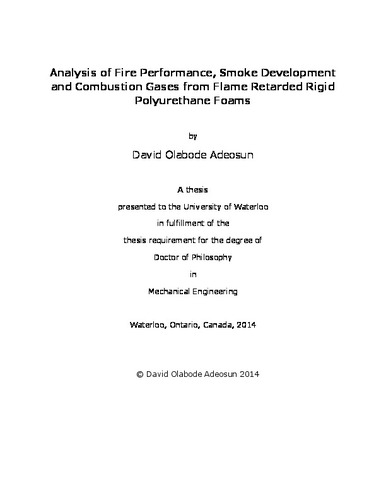| dc.description.abstract | Rigid polyurethane foam is a polymeric material which is widely used for thermal insulation in building construction and other applications. Given recent emphasis on energy conservation and efficiency, there has been continuous growth in its use over the years. This raises significant fire safety concerns since polyurethanes are inherently very flammable and prone to release toxic gases as the foam thermally decomposes and burns. To improve fire safety characteristics by reducing ignitability and flammability of the foams, various flame retardants (FR) have been introduced into base foam formulations. But with the introduction of FR agents, there has been rising concern within the fire safety community and general public regarding the overall benefits versus detrimental impacts of even commonly used FR agents. In the case of rigid polyurethane foam, however, such an assessment is difficult as there are few cross comparisons in the literature that detail the impacts of different concentrations of common fire retardants, such as brominated, phosphorus-based and expandable graphite agents, on the fire behavior, smoke development and toxic gas production for even single base foam formulations.
The present experimental work focuses on a systematic evaluation of these factors using three common, commercial fire retardants added in concentrations of 0%wt, 10%wt and 20%wt to a single formulation of rigid polyurethane foam. Cone calorimeter and smoke density tests are used to simulate well ventilated and poorly ventilated fire conditions during material fire performance assessment, while FTIR, Novatech P 695 gas analyzers and TD-GC/MS methods are used to investigate the gases evolved during oxidative pyrolysis and combustion of the samples. Concentration measurements of principal fire gases such as CO, CO2, reduced O2, and NOx
are combined with more detailed investigation of the volatile organic compounds generated during the fire testing. Use of gas absorption sampling followed by off-line Thermal Desorption/Gas Chromatography/Mass Spectrometry (TD-GC-MS) analysis for identification of toxic gases has proven of significant benefit in this application. The full set of data obtained provides a more comprehensive identification of the evolved products during three characteristic periods in the combustion process. As such, it expands current knowledge and provides valuable new insight and understanding of thermal degradation, combustion and smoke development, as well as overall fire performance, of fire retarded rigid polyurethane foams in well-ventilated and poorly ventilated environments. | en |

